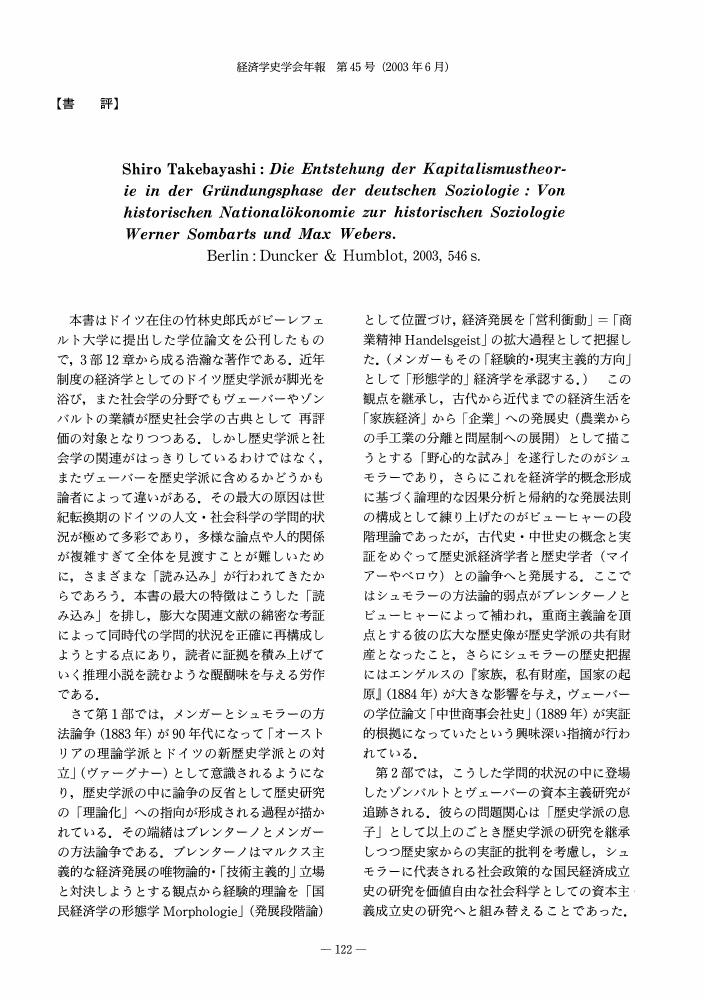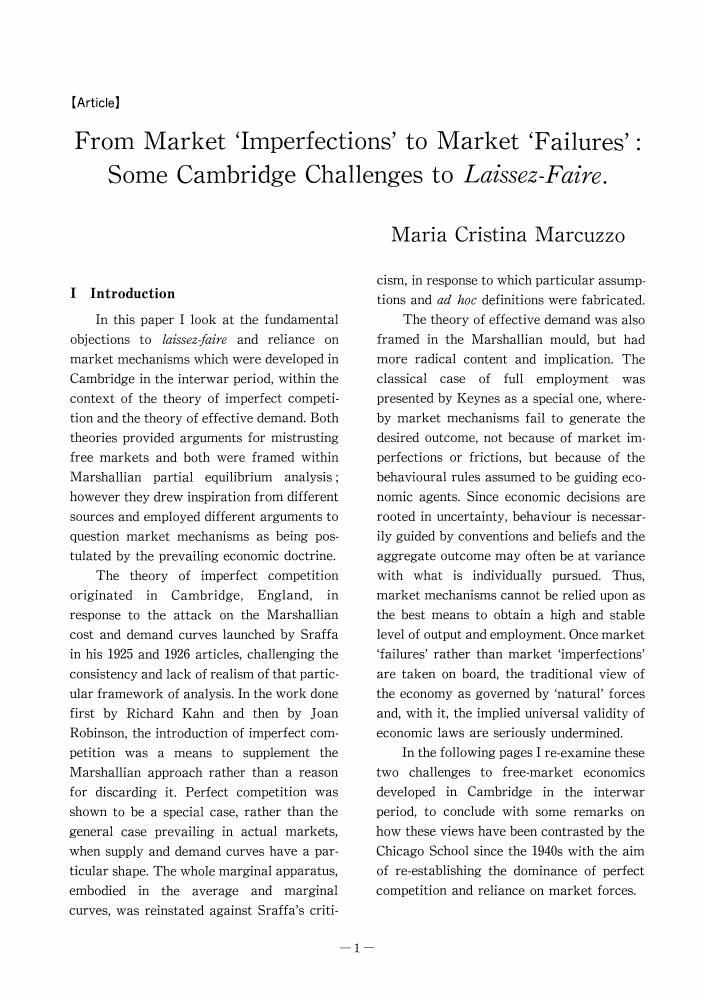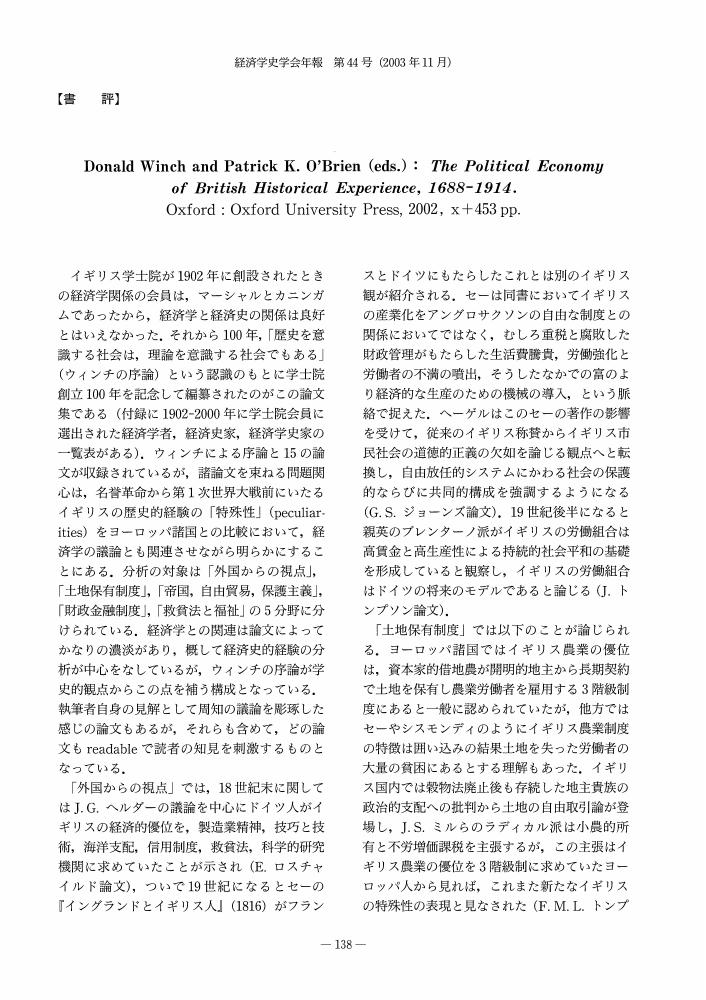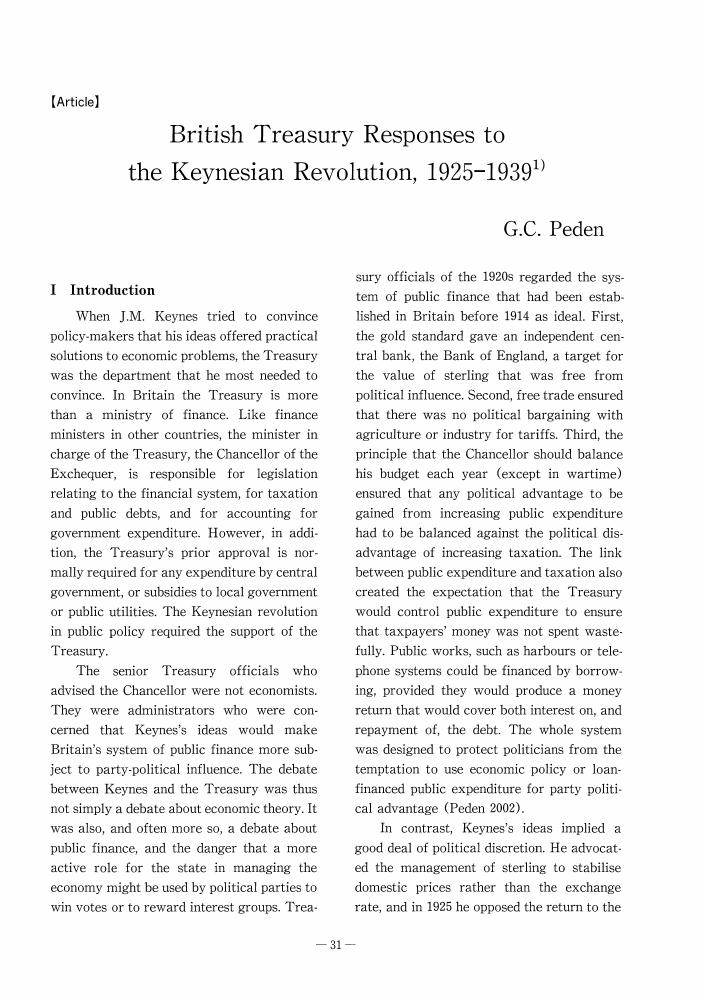1 0 0 0 OA ジョーゼフ・ラウントリーのガーデン・ビレッジ構想
- 著者
- 岡村 東洋光
- 出版者
- The Japanese Society for the History of Economic Thought
- 雑誌
- 経済学史学会年報 (ISSN:04534786)
- 巻号頁・発行日
- vol.46, no.46, pp.31-47, 2004 (Released:2010-08-05)
- 参考文献数
- 63
The purpose of this paper is to investigate Joseph Rowntree's philanthropy, and in particular, the Garden Village he founded, and then to clarify the importance of it as the model of a community that was like a neighbourhood unit, and as the inspiration behind the creation of the Welfare State in Britain.In the late 19th century, two successful entrepreneurs, T. Salt and E. Akroyd, had founded the villages of Saltaire and Akroydon, respectively. They were located very close to the big mills that employed their workers. These villages somewhat improved the living conditions of their employees. In London, some funding was invested in improving housing conditions and received a 5per cent commercial return. Subsequently, the setting up of the Peabody Trust in 1862 led the way for others to follow, and the endowment of trusts by philanthropic individuals developed through the Guinness Trust which was started in 1889, the Sutton Housing Trust, founded in 1900, and the Samuel Lewis Trust, foundes in 1906.But the great estate William Sutton left gave rise to fundamental social and political issues, in particular the role of charity in the provision of housing and relief of poverty. The size of his bequest raised fears that the trust could monopolise housing for the poor, disrupting local housing markets and undermining the rateable base of local authority income. Finally, the High Court of Chancery retained the direction of the Sutton Trust's affairs, exercising control over the initial funds and all surpluses generated.Around the same time, in Birmingham, the Cadbury family moved their factory from the city centre to the countryside, to a site later renamed Bournville. While the factory was under construction, some attractive cottages were erected nearby. An experimental housing estate followed a few years later, which in 1900 became the Bournville Village Trust, a product of the age that created the Garden Cities' movement. In a sense, it was the philanthropic ideal that created this community.In 1904, Joseph Rowntree, using approximately half his fortune, set up three separate Trusts. One of those was the JR Village Trust, which was concerned with living conditions and in particular with the houses at New Earswick, known as Garden Village. Through this Trust, an effort was made to provide houses that were artistic in appearance, sanitary, and thoroughly well-built yet within the means of working men earning about 25s. a week (i. e., the lowest incomegroup). In short, this project aimed to improve the housing of Rowntree's workers. Rowntree simultaneously intended to create a community that functioned like a neighbourhood unit. And so, for the inhabitants, the new village would mean something more than bricks and mortar.Through the founding Garden Village and the providing of houses for his workers, the middle-class Rowntree philanthropically pursued social reform for the public good as he saw it. We can say that the Garden Village still lives on, and continues to play the role for which Rowntree intended it, of providing welfare for the poor.
- 著者
- 只腰 親和
- 出版者
- The Japanese Society for the History of Economic Thought
- 雑誌
- 経済学史学会年報 (ISSN:04534786)
- 巻号頁・発行日
- vol.45, no.45, pp.115-116, 2004 (Released:2010-08-05)
- 著者
- 高 哲男
- 出版者
- The Japanese Society for the History of Economic Thought
- 雑誌
- 経済学史学会年報 (ISSN:04534786)
- 巻号頁・発行日
- vol.45, no.45, pp.120-121, 2004 (Released:2010-08-05)
- 著者
- 田村 信一
- 出版者
- The Japanese Society for the History of Economic Thought
- 雑誌
- 経済学史学会年報 (ISSN:04534786)
- 巻号頁・発行日
- vol.45, no.45, pp.122-124, 2004 (Released:2010-08-05)
1 0 0 0 OA J. M. クラークの社会経済学のヴィジョン
- 著者
- 佐藤 方宣
- 出版者
- The Japanese Society for the History of Economic Thought
- 雑誌
- 経済学史学会年報 (ISSN:04534786)
- 巻号頁・発行日
- vol.45, no.45, pp.40-54, 2004 (Released:2010-08-05)
- 参考文献数
- 40
In the late 1910s, John Maurice Clark insisted that traditional economics (value economics and price economics) was becoming irrelevant to the problems of “an era of social readjustment, ” advocating the need for another type of economic theory which he called “social economics.” This conception of social economics had a place in the basis of his economic thought, and core ideas of his works in the interwar periods, such as Studies in the Economic of Overhead Cost (1923) or Social Control of Business (1926), were corollaries of the fundamentals of his social economics.In this paper, we scrutinize the original plan of John Maurice Clark's social economics logically and historically, and clarify its nature and relevant historical contexts, especially its relationship with the institutionalism movements and the implication of Clark's discussions with Anderson, Jr. on the meaning of social value in economic theory.First, we consider why Clark advocated that social economics must become a centerpiece of economics. This was derived from his relative view of the nature of economic theory, which, he thought, had to reflect dynamic social and economic changes. This is why price economics which was based on static premises and whose materials were selected with reference to a logical “closed system” were irrelevant to problems in an era of reconstruction after the World War I. He claimed that it must become a subordinate part of economics.Secondly, we examine the framework of Clark's social economics which he described as “non-Euclidean.” Clarifying the premises of traditional economics, he presented relevant premises of social economics, such as a concept of wealth as “inappropriables, ” a need for qualitative standards of economic activity, a universal nature of overhead cost, a problem of mechanization, and so on. He proposed that these aspects of social economics reflected the context of that time, such as an appearance of Big Business Systems, and the experience of the World War I.Finally, we examine the backgrounds of Clark's advocacy of social economics, placing it in the context of the American economic thought of the time. We clarified its connection with the emergence of institutionalism movements led by Hamilton and other young economists, and with the controversy regarding the concept of social value. On the one hand, Hamilton's critical judgment for traditional economics and claim for institutional economics took the same approach as Clark's social economics. Therefore they had become representatives of institutionalists in the interwar period. On the other hand, by examining Clark's discussions with Anderson Jr., we recognize that they shared same context of the discussion of social value, started from John Bates Clark's Philosophy of Wealth (1885). This seems to be one of the main sources of J. M. Clark's emphasis on the need for a social value standard which implied a valuation not based on actual market prices.
1 0 0 0 OA 日本経済思想史: 政策学から経済学へ
- 著者
- 藤井 隆至
- 出版者
- The Japanese Society for the History of Economic Thought
- 雑誌
- 経済学史学会年報 (ISSN:04534786)
- 巻号頁・発行日
- vol.45, no.45, pp.55-65, 2004 (Released:2010-08-05)
- 参考文献数
- 108
The third report in the present series, this paper offers an analysis of important recent studies (from 1980 to the present) of Japanese economic policy and thought in the 1910's and 20's.The economy of Japan following WWI can be described particularly in terms of its emphases on scientific development and industrial production. However, this progress in industrial development led to the appearance of a widened gap between rich and poor, and one of the major issues concerning the economic thought of the time was how to improve the lot of the poorer levels of society, including workers, farmers and city dwellers.Research in the field of economics during the 1910's and 20's had as one of its focal points the attempt to alleviate this exaggerated difference between the haves and havenots. The economics of the Association for the Study of Social Policy attempted to reduce the gap between rich and poor through the implementation at a national level of specific social policies. The ineffectiveness of these policies, however, resulted in a lack of faith in the ability of the Association to do anything about the situation in a concrete way.The crumbling of the economic policies associated with this Association for the Study of Social Policy allowed for the appearance new approaches, such as the Neoclassical economics of Tokuzo Fukuda and the Marxist economics of Hajime Kawakami.The present study introduces the work of Kanae Iida and Kanji Kobayashi. Seeking an approach to the study of economics based on firmly-grounded economic theories, this paper presents and comments on the work of Kanae Iida, Mikio Nishioka, Takutoshi Inoue, Tamotsu Nishizawa, Hideomi Tanaka, who themselves each analyzed the ideas of Tokuzo Fukuda. It also introduces and comments on the work of Shiro Sugihara, who investigated the thought of Hajime Kawakami.This paper also presents the research of Kunio Yanagita, and comments on the ideas of Yoshiteru Iwamoto and Takashi Fujii, with a particular emphasis on the idea that a suitable ethical policy is critical to the success of any given economic policy.Finally, this paper reports a decline, dating from the 1980's to the present day, in the number of studies of particular economic questions and problems, accompanied by a corresponding increase in research on historical individuals. However, it suggests that the work of Aiko Ikeo and others seems to be slowly bringing about a return to a question-centered focus.
- 著者
- 松本 有一
- 出版者
- The Japanese Society for the History of Economic Thought
- 雑誌
- 経済学史学会年報 (ISSN:04534786)
- 巻号頁・発行日
- vol.44, no.44, pp.146-147, 2003 (Released:2010-08-05)
- 著者
- Susumu Egashira
- 出版者
- The Japanese Society for the History of Economic Thought
- 雑誌
- 経済学史学会年報 (ISSN:04534786)
- 巻号頁・発行日
- vol.44, no.44, pp.148-150, 2003 (Released:2010-08-05)
- 著者
- 久保 真
- 出版者
- The Japanese Society for the History of Economic Thought
- 雑誌
- 経済学史学会年報 (ISSN:04534786)
- 巻号頁・発行日
- vol.44, no.44, pp.151-153, 2003 (Released:2010-08-05)
- 著者
- 川俣 雅弘
- 出版者
- The Japanese Society for the History of Economic Thought
- 雑誌
- 経済学史学会年報 (ISSN:04534786)
- 巻号頁・発行日
- vol.44, no.44, pp.154-155, 2003 (Released:2010-08-05)
1 0 0 0 OA From Market ‘Imperfections’ to Market ‘Failures’: Some Cambridge Challenges to Laissez-Faire
- 著者
- Maria Cristina Marcuzzo
- 出版者
- The Japanese Society for the History of Economic Thought
- 雑誌
- 経済学史学会年報 (ISSN:04534786)
- 巻号頁・発行日
- vol.45, no.45, pp.1-10, 2004 (Released:2010-08-05)
- 参考文献数
- 40
- 著者
- Yoshihiko Hakamata
- 出版者
- The Japanese Society for the History of Economic Thought
- 雑誌
- 経済学史学会年報 (ISSN:04534786)
- 巻号頁・発行日
- vol.45, no.45, pp.11-25, 2004 (Released:2010-08-05)
- 参考文献数
- 23
1 0 0 0 OA ハイエクに対するシュパンの影響
- 著者
- 江頭 進 塘 茂樹
- 出版者
- The Japanese Society for the History of Economic Thought
- 雑誌
- 経済学史学会年報 (ISSN:04534786)
- 巻号頁・発行日
- vol.45, no.45, pp.26-39, 2004 (Released:2010-08-05)
- 参考文献数
- 44
This paper deals with the influence of Othmar Spann, a Viennese professor of economics and sociology during the interwar period, on the development of Hayek's ideas. Spann was an examiner of Hayek when he obtained his Ph. D. in Political Science, and Hayek was a regular member of the Spann circle. Moreover, there is, at least on the surface, a similarity between Hayek's core theory of the Spontaneous Order developed mainly after the 1960s and Spann's Universalism.Hayek avoided mentioning Spann after the 1930s. However, in this article, we propose the hypothesis that Hayek never forgot Spann's arguments yet always maintained some distance from him. Hayek developed the theory of Spontaneous Order as an idea based on methodological individualism from the 1940s to the 1960s. However, some recent studies have pointed out the conflict between methodological individualism and holism in The Fatal Conceit (1988). Moreover, it is pointed out that his argument in later years has a holistic or institutional character compared with Friedman or Rothbard because he develops his assertion on the basis of the theory of Spontaneous Order. If we can accept this and the fact that our society largely depends on spontaneous order, there is a possibility that the problem of totalitarianism still remains. In this sense, the relationship between Hayek and Spann is one of the current issues in political economy.Hayek was always cautious about the confusion between his arguments and the assertion of conservatism, and we can say the same thing about Hayek and Spann's arguments. This fact suggests that analysis of the similarity and difference between the arguments of Hayek, which are one of the most important streams of modern liberalism, and those of Spann, is important from the viewpoint not only of the historical studies of social science but also in modern political science.In this article, we consider this hypothesis in three stages. First, we outline Spann's Universalism and Hayek's conception of the individualism. Second, we consider the influence of Spann on Hayek's doctoral dissertation. His dissertation deals with the Imputation Theory and the first half discusses the problem proposed by Spann. Third, we analyse the structural similarity between the arguments of Hayek after the 1970s and those of Spann. This similarity can be clarified in the light of evolutionism and relativeness.
- 著者
- 熊谷 次郎
- 出版者
- The Japanese Society for the History of Economic Thought
- 雑誌
- 経済学史学会年報 (ISSN:04534786)
- 巻号頁・発行日
- vol.44, no.44, pp.138-140, 2003 (Released:2010-08-05)
1 0 0 0 OA Tiziano Raffaelli: Marshall's Evolutionary Economics. London: Routledge, 2003, Xiii+178pp.
- 著者
- 近藤 真司
- 出版者
- The Japanese Society for the History of Economic Thought
- 雑誌
- 経済学史学会年報 (ISSN:04534786)
- 巻号頁・発行日
- vol.44, no.44, pp.141-142, 2003 (Released:2010-08-05)
- 著者
- 姫野 順一
- 出版者
- The Japanese Society for the History of Economic Thought
- 雑誌
- 経済学史学会年報 (ISSN:04534786)
- 巻号頁・発行日
- vol.44, no.44, pp.143-145, 2003 (Released:2010-08-05)
- 著者
- Tetsuo Taka
- 出版者
- The Japanese Society for the History of Economic Thought
- 雑誌
- 経済学史学会年報 (ISSN:04534786)
- 巻号頁・発行日
- vol.44, no.44, pp.17-30, 2003 (Released:2010-08-05)
- 参考文献数
- 40
- 著者
- G. C. Peden
- 出版者
- The Japanese Society for the History of Economic Thought
- 雑誌
- 経済学史学会年報 (ISSN:04534786)
- 巻号頁・発行日
- vol.44, no.44, pp.31-44, 2003 (Released:2010-08-05)
- 参考文献数
- 27
1 0 0 0 OA ヘンリー・クレイにおける産業, 組織, 協業
- 著者
- 若森 みどり
- 出版者
- The Japanese Society for the History of Economic Thought
- 雑誌
- 経済学史学会年報 (ISSN:04534786)
- 巻号頁・発行日
- vol.44, no.44, pp.45-58, 2003 (Released:2010-08-05)
- 参考文献数
- 18
Henry Clay [1883-1954] was known as a strong advocate of “rationalisation” in the decade of the 1920s. In 1933 he was appointed to an economic adviser of Montague Norman who was the governor of the Bank of England. The purpose of this paper is to examine Clay's ideas regarding the industry, economic organisation, and co-operation that evolved in the period from 1916 to 1929.Clay lectured on economics for the Worker's Educational Association between 1909 and 1917, and published a book entitled Economics: an Introduction for the General Reader [1916]. Clay's intention was to explain the social arrangements which make the business transaction “possible.” For Clay, economics should be the study of business in its social aspect; it is the object of economics to explain such arrangements in detail and to show how the system works, and economists should study what points of contact the economic order has with the political order, and how far the economic order harmonies with the moral order. Criticizing “a survival from the period of orthodox laissez faire, ” Clay suggested that the object of economics was not the advocacy of the present economic system. Focusing on specialisation and the production system's dependence on anticipated demand, Clay treated difficulties such as severe fluctuations, over-production, and the unemployment that accompanied them as “imperfections of co-operation.” Clay closely evaluated the social role of businessmen in organizing and co-ordinating industry both efficiently and morally, because they prevented those difficulties. In addition, Clay insisted that the economic organisation in the past had been moralized by the action of the State quite as much as through the economic actions of individuals; a few examples would be the reform of the early factories, the abolition of infant labour in mines, the regulation of dangerous trades, and the prevention of deleterious adulteration, all of which had needed the intervention of the State.After the First World War, the economic conditions and circumstances dramatically changed. Clay came to consider that the most urgent problem was how to reconstruct the British industry. Immediately following the war, Clay insisted on the need for the imperative leadership of government to reset an industrial order for peace (Clay 1918). However, the government did not take such measures. So Clay blamed the difficulties of the post-war unemployment problem and those of depressed industries on the mismanagement of the government including the return to the gold standard (Clay 1929a, 1929b). The greater comparative depression of the export industries was one of the most striking features of the post-war period. In late 1920s, Clay suggested “rationalisation”: the regeneration of private enterprise or the amalgamation of small businesses by banks. Clay regarded the banks to have the ability to reorganize finance and give strategic knowledge to firms, both of which were necessary for efficient management.
1 0 0 0 OA J. S. ミルにおける認識論と宗教の関係
- 著者
- 船木 恵子
- 出版者
- The Japanese Society for the History of Economic Thought
- 雑誌
- 経済学史学会年報 (ISSN:04534786)
- 巻号頁・発行日
- vol.44, no.44, pp.59-74, 2003 (Released:2010-08-05)
- 参考文献数
- 29
The purpose of this paper is to examine the religious descriptions of J. S. Mill in relation to his epistemology. As far as religion was concerned, Mill, as is well known, was not educated in a theistic atmosphere. His attitude to christianity may be open to some serious questioning. Mill maintained empiricist positions throughout his life. Many empiricists adopted an agnostic position. Of course Mill approved of agnosticism and attempted to reject the “Argument for a First Cause” as having no basis in experience. This paper discloses Mill's epistemological attitude and the new interpretation of “Religion of Humanity” that differ from recent studies. One of the recent trends of Mill studies is to focus on his “Religion of Humanity” and to show its resemblance to that of Auguste Comte. However, this interpretation ignores the fact that Mill was critical to the latter day argument of Comte. In contrast, this paper deals the religious writing of Mill with the careful examination of his discussion of epistemology.Section one of this paper presents recent studies of Mill's religious thought. As previously noted, Mill's religious descriptions are combined with his epistemology. This paper states that the only reseach of Three Essays on Religion is imperfect, and in order to grasp exactly Mill's religious thought, we have to deal with his wide works, and study from an all-around view. However, Mill's conventional religious studies were concentrated in his Three Essays on Religion. Recently, however, original research of Mill has focused on “Religion of Humanity.” Such studies include those of Humberger and Raeder. Section one states that their studies are novel but inadequate regarding their treatment of Comte.Section two of this paper delves into Mill's religious directions. This section is composed of two segments. The first segment shows that Mill's religious directions are of three types. The second segment describes Mill's particular Argument of Design.Section three of this paper provides a close discussion of two famous intuitionists of the nineteenth century, William Whewell and Sir William Hamilton. Mill made pointed remarks about Whewell and Hamilton's intuitionism. The propose of this section is to explain why Mill attacked intuitionism.Section four constitutes the core of this paper. This section considers Mill's “Religion of Humanity” and Inverse Deductive, or Historical Method, which he treated in the sixth volume of A System of Logic. From the standpoint of human nature, Mill tries to rewrite the “Doctrine of Necessity.” Mill had to accept a distance between a social phenomenon and his epistemology. Mill states human actions are never uncontrollable, and in order to show this idea, Mill suggests the Historical Method.Thus, when we trace Mill's religious descriptions, we discover Mill's particular-epistemological thought relating to human will. The relationship of Mill's “Religion of Humanity” and the Historical Method lead tothe conclusion that Mill's religious background has an epistemological dimension.













